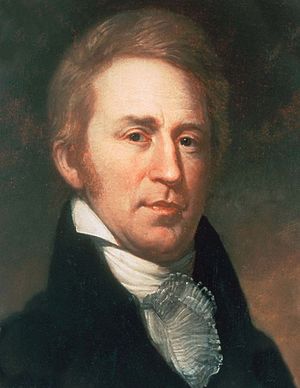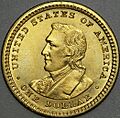William Clark facts for kids
Quick facts for kids
William Clark
|
|
|---|---|
 |
|
| 4th Governor of Missouri Territory | |
| In office July 1, 1813 – September 18, 1820 |
|
| Appointed by | James Madison |
| Preceded by | Benjamin Howard |
| Succeeded by | Alexander McNair |
| Superintendent of Indian Affairs | |
| In office 1822 – September 1, 1838 |
|
| Preceded by | Position established |
| Succeeded by | Thomas L. McKenney |
| Personal details | |
| Born | August 1, 1770 Ladysmith, Colony of Virginia |
| Died | September 1, 1838 (aged 68) St. Louis, Missouri, U.S. |
| Spouses |
|
| Relations |
|
| Occupation |
|
| Signature | |
| Military service | |
| Branch/service | Infantry Artillery |
| Years of service | 1792–1796 1804–1807 |
| Rank | Lieutenant Second lieutenant, First lieutenant |
| Unit | Legion of the United States Regiment of Artillerists |
| Commands | Corps of Discovery |
| Battles/wars | Battle of Fallen Timbers |
William Clark (born August 1, 1770 – died September 1, 1838) was an important American explorer, soldier, and leader. He was born in Virginia and grew up in Kentucky. Later, he settled in what is now Missouri.
Clark is best known for leading the Lewis and Clark Expedition from 1804 to 1806. With Meriwether Lewis, he explored the vast lands of the Louisiana Purchase all the way to the Pacific Ocean. This was the first big trip to map and explore the Western United States. It also helped the U.S. claim land in the Pacific Northwest.
After the expedition, Clark continued to serve his country. He was a governor of the Missouri Territory. He also worked as the Superintendent of Indian Affairs from 1822 until he died.
Contents
William Clark's Early Life
William Clark was born in Caroline County, Virginia, on August 1, 1770. He was the ninth of ten children. His parents, John and Ann Rogers Clark, were farmers who owned land and a few slaves.
Clark did not go to a formal school. He was taught at home, like many people back then. He sometimes worried about his writing and spelling. For example, he spelled "Sioux" 27 different ways in his journals! Even so, his writings show he read a lot.
Clark's five older brothers fought in the American Revolutionary War (1775–1783). William was too young to join. His brother, George Rogers Clark, became a general. He fought against British-allied American Indians in Kentucky. After the war, the Clark family moved to Kentucky.
In March 1785, William and his family arrived in Kentucky. They traveled by land and then by flatboat down the Ohio River. The family settled at "Mulberry Hill" near Louisville. This was William's main home until 1803. In Kentucky, his older brother George taught him important survival skills for the wilderness.
Starting a Military Career
In Kentucky, people fought in the Northwest Indian War. This war was against American Indians who wanted to protect their land north of the Ohio River. In 1789, 19-year-old William Clark joined a volunteer army group. He started keeping a detailed journal, which he did for the rest of his life.
In 1792, Clark became a lieutenant in the Legion of the United States. He was involved in fights with Indians during the Northwest Indian War. At the Battle of Fallen Timbers in 1794, Clark led a group of riflemen. They pushed back the enemy and helped the U.S. win. This victory ended the Northwest Indian War.
The Lewis and Clark Expedition
William Clark left the army on July 4, 1796, because he was not feeling well. He was only 26 years old. He went back to his family's farm, Mulberry Hill, near Louisville.
In 1803, Meriwether Lewis asked Clark to help lead a new group called the Corps of Discovery. Clark was 33 at the time. Their mission was to explore the huge area of the Louisiana Purchase. They also needed to trade with Native Americans and show that the U.S. owned the land. A big goal was to find a water route from the U.S. to the Pacific Ocean. They also wanted to claim the Oregon territory for the United States before other European countries did.
Clark spent three years on this amazing journey to the Pacific Coast. He brought York, one of his slaves, with him. Native American groups treated York with respect. Many were very interested in him, and his presence helped with talks between the explorers and the tribes.
Even though Clark was not officially promoted to captain, he shared equal power with Lewis. Clark mainly focused on drawing maps, managing supplies, and leading hunting trips.
Working with Native American Nations
In 1807, President Jefferson made Clark a general in the Louisiana Territory army. He also became the U.S. agent for Indian affairs. This meant he would work with Native American tribes. Clark set up his main office in St. Louis, Missouri, where he lived for most of his life.
Clark's experiences during his expedition helped him become a good diplomat for Native Americans. He understood their cultures and languages. He worked to protect them and their traditions. He tried to keep them away from some of the negative influences of white society. He also helped provide important vaccinations and collected their artifacts for a museum.
However, Clark also had to carry out U.S. government policies. This meant moving Indians from their traditional lands. He also encouraged programs to change their ways of life and beliefs. He usually put the interests of American citizens first.
During the War of 1812, Clark led several military actions. In 1814, he led a campaign along the Mississippi River. He helped establish Fort Shelby in what is now Wisconsin.
When the Missouri Territory was created in 1813, President Madison appointed Clark as its governor. He was reappointed twice more. Clark served as governor for seven years. He was voted out of office in 1820, in the first election after Missouri became a state. Alexander McNair won the election.
In 1822, President Monroe appointed Clark as the Superintendent of Indian Affairs. This was a new position. Clark held this job until he died. He was the most important person dealing with Native American matters west of the Mississippi River.
Clark tried to keep peace with Native American nations and signed peace treaties. But he also had to carry out President Andrew Jackson's policy of Indian removal. This policy forced many tribes to move from their homes. Clark expressed sympathy for these tribes. However, he agreed with and carried out the policy. He negotiated 37 treaties, which moved millions of acres of land from Indian to U.S. ownership.
Family Life and Marriage
After his big expedition, Clark married Julia Hancock on January 5, 1808. They had five children:
- Meriwether Lewis Clark, Sr. (1809–1881), named after his friend Lewis.
- William Preston Clark (1811–1840).
- Mary Margaret Clark (1814–1821).
- George Rogers Hancock Clark (1816–1858), named after his older brother.
- John Julius Clark (1818–1831).
After Julia died in 1820, William Clark married her cousin, Harriet Kennerly Radford. They had three children together:
- Jefferson Kearny Clark (1824–1900), named after the president.
- Edmund Clark (1826–1827).
- Harriet Clark (died as a child).
His second wife, Harriet, died in 1831.
Clark also acted as a guardian for Jean Baptiste Charbonneau. He was the son of Sacagawea, the famous Native American woman who helped the Lewis and Clark Expedition.
Later Life and Passing
William Clark passed away in St. Louis on September 1, 1838, at 68 years old. His funeral was a very large event. The procession stretched for over a mile, and cannons fired a military salute. The whole city of St. Louis mourned his death.
Clark and six of his family members were later reburied at Bellefontaine Cemetery in 1860. A tall, gray granite monument marks their graves. It was dedicated in 1904, 100 years after the Louisiana Purchase. Clark's son, Jefferson Kearney Clark, designed the monument. It was restored and rededicated in 2004, marking 200 years since the Corps of Discovery left St. Charles, Missouri. Leaders from the Shoshone, Osage, and Mandan tribes spoke at the ceremony.
Honors and Legacy
- In 1814, Clark was chosen as a member of the American Antiquarian Society.
- In 2001, President Bill Clinton promoted Clark to the rank of captain in the U.S. Army after his death.
- The western American plant group Clarkia is named after him. So are the cutthroat trout (Oncorhynchus clarki) and Clark's nutcracker (Nucifraga columbiana). These were species Clark identified during the expedition.
- Meriwether Lewis and William Clark were honored with a 3-cent stamp in 1954.
- Both Lewis and Clark appear on the gold Lewis and Clark Exposition dollar coins. These coins were made in 1904 and 1905.
- The St. Louis Walk of Fame includes Clark.
- Counties in six states are named in his honor: Arkansas, Idaho, Kentucky, Missouri, Montana, and Washington.
- The city of Clarkston, Washington is named for him.
- Several rivers are named after him, including the Clarks River in Kentucky and the Clark Fork in Montana and Idaho.
- Two U.S. Navy ships, the USS Lewis and Clark and the USNS Lewis and Clark, were named for him and Lewis.
- The Clark Bridge across the Mississippi River is named after him.
- Several colleges and schools are named after Lewis and Clark, such as Lewis and Clark Community College and Lewis and Clark Law School.
- In 1965, Clark was added to the Hall of Great Westerners at the National Cowboy & Western Heritage Museum.
Images for kids
See also
 In Spanish: William Clark para niños
In Spanish: William Clark para niños



